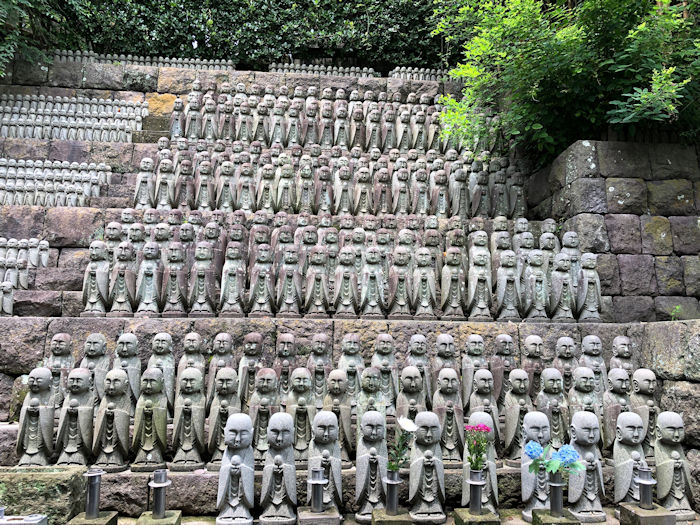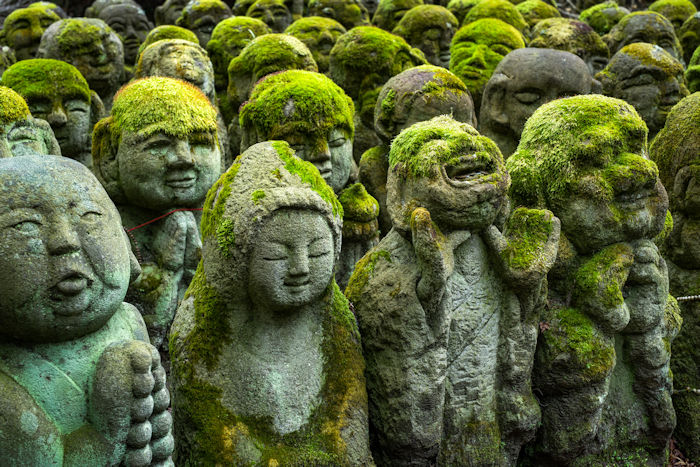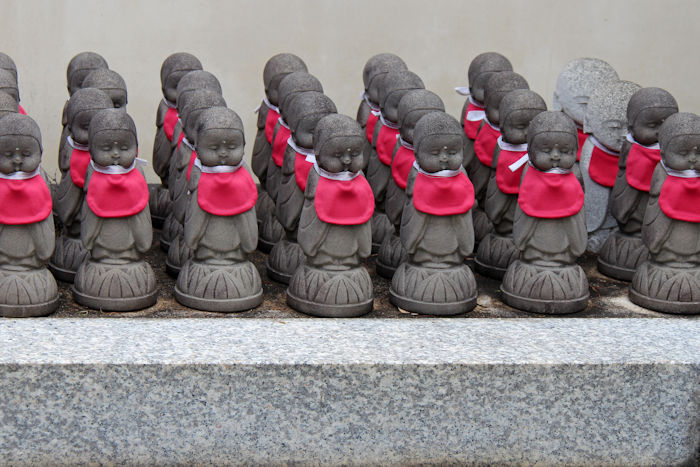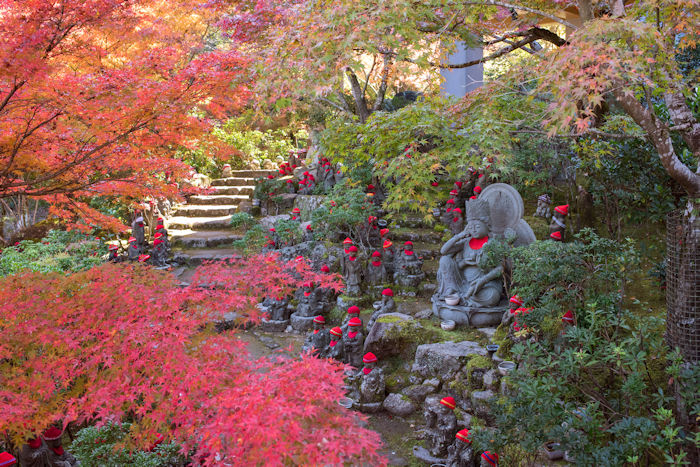Jizo – Protector Of Children, Travelers And Women In Japanese Mythology
Ellen Lloyd - AncientPages.com - As a protector of children, women, and travelers, Jizo (Jizō ) plays an important role in Japanese mythology.
Rows of stoneJizo statues in the Hasedera temple garden in Kamakura. Credit: Adobe Stock - QBE852
When you visit one of the 190,000 temples and shrines or a cemetery in Japan, you can easily find a Jizo statue because they appear in large numbers. Jizo statues are often very cute, and they take on countless forms. They can be male, female, adult, and child. Most often, Jizo appears as a small monk-like figure.
Jizo - One Of The Most Popular Buddhist Divinities
Jizo is the Japanese version of Bodhisattva Ksitigarbha, a Buddhist god worshiped mainly in East Asia. Jizo is, without doubt, one of the most popular and lovable of the Buddhist divinities. He has all the wisdom of the Lord Buddha himself, with this important difference: Jizo has waived aside Nirvana and does not sit upon the Golden Lotus but has become, through exquisitely beautiful self-sacrifice, the divine playmate and protector of Japanese children.
Jizo – Protector Of Children, Travelers, Women And The Weak
Jizo has many functions and duties, but the most important of them all is that he acts as a protector of children and unborn children who died before their parents. According to Japanese Buddhist stories, children who face judgment in the afterlife are doomed to stack rocks on the riverbed of souls in purgatory because they didn't have a chance to build up good karma on earth. Jizo helps these children to cross the river in the sleeves of his robe.
Stone statues at the Otagi Nenbutsu ji temple in Kyoto, Japan. Credit: Adobe Stock - eyetronic
He is the God of smiles and long sleeves, the enemy of evil spirits, and the one being who can heal the wound of a mother who has lost her child in death. Jizo is also the guardian of travelers, women, and the weak.
The Visit Of Jizo Is Much Dreaded
An intriguing custom occurs in Izumo, a Shimane Prefecture, Japan city.
When a wedding occurs in the house of an unpopular man in the country, the village's young men carry a roadside statue of Jizo into the Zashiki and announce the coming of God.
Kyoto, Japan. Credit: Adobe Stock - frdric
God demands food and wine. The family members must come in, salute the deity, and give all the saké and food demanded while any remains in the house. Refusing is dangerous; the young peasants would probably wreck the house. After this, the statue is carried back again to its place. The visit of Jizō is much dreaded. It is never made for persons who are liked.
Jizo Statues Can Be Found All Over Japan
Due to his popularity, we can find depictions of Jizo in many places in Japan. Jizo is the first deity most people encounter when they set foot in Japan. This is because he is the protector of travelers.
You can find Jizo peeking out among the grasses along the road, standing at intersections, overseeing borders, or sitting in a wooden shelter built especially for him. Jizo is at temples too, where sometimes he holds a baby in his arms. He is found at boundaries between physical and spiritual places, between here and there, life and death.
Daisho-in Temple in Miyajima, Hiroshima, Japan. Credit: Adobe Stock - wooooooojpn
Jizo statues are very often carved out of a rock. According to Hank Glassman, associate professor of East Asian Studies at Haverford College in Pennsylvania and author of “The Face of Jizo: Image and Cult in Medieval Japanese Buddhism” the material of the Jizo statue is important. The power of stones to engage the human heart.” Stone is a material that has been worshipped and used for protection since ancient times. Stones having spiritual value predates Buddhism.
Red Maple leaf on the head of Jizo sculpture doll (little Japanese Buddhist monk doll rock) in Japanese Garden.
Credit: Adobe Stock - structuresx
Jizo statues are often dressed in a small red bib around their necks. This practice of dressing Jizo includes hats, robes, or anything one wishes to adorn his figure. Such red bibs were said to have been worn by children earlier. Although the bibs are usually red, representing safety and protection, they can be any color, fabric, or pattern.
Jizo represents a monk; when people dress a monk statue, they accrue merit. Dressing Jizo gives people a chance to interact with him.
Updated on August 2, 2023
Written by Ellen Lloyd – AncientPages.com
Copyright © AncientPages.com All rights reserved. This material may not be published, broadcast, rewritten or redistributed in whole or part without the express written permission of AncientPages.com
More From Ancient Pages
-
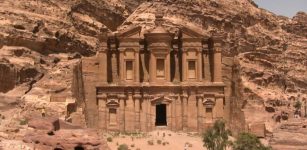 Unclear Purpose Of Mysterious Rock-Cut City Of Petra – Was It A Fortress Or Sacred City?
Featured Stories | May 30, 2020
Unclear Purpose Of Mysterious Rock-Cut City Of Petra – Was It A Fortress Or Sacred City?
Featured Stories | May 30, 2020 -
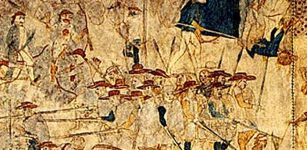 On This Day In History: Spanish Villasur Expedition Wiped Out By Pawnee And Otoe Warriors – On August 14, 1720
News | Aug 14, 2016
On This Day In History: Spanish Villasur Expedition Wiped Out By Pawnee And Otoe Warriors – On August 14, 1720
News | Aug 14, 2016 -
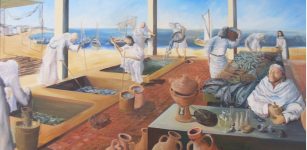 Mediterranean Hunter-Gatherers Relied On Marine Resources More Than Previously Thought
Archaeology | Feb 22, 2023
Mediterranean Hunter-Gatherers Relied On Marine Resources More Than Previously Thought
Archaeology | Feb 22, 2023 -
 Where Does The Expression ‘Saved By A Bell’ Come From?
Ancient History Facts | Oct 16, 2019
Where Does The Expression ‘Saved By A Bell’ Come From?
Ancient History Facts | Oct 16, 2019 -
 Goblins: Antisocial, Grotesque, Ugly And Vengeful Fairy Creatures In Ancient Beliefs
Featured Stories | Dec 6, 2018
Goblins: Antisocial, Grotesque, Ugly And Vengeful Fairy Creatures In Ancient Beliefs
Featured Stories | Dec 6, 2018 -
 Skaftö Wreck’s Cargo Gives New Answers About 15th Century Trade Routes
Archaeology | Oct 25, 2022
Skaftö Wreck’s Cargo Gives New Answers About 15th Century Trade Routes
Archaeology | Oct 25, 2022 -
 White Temple Of God Anu In Sacred Precinct Of Kullaba At Uruk
Civilizations | Oct 10, 2016
White Temple Of God Anu In Sacred Precinct Of Kullaba At Uruk
Civilizations | Oct 10, 2016 -
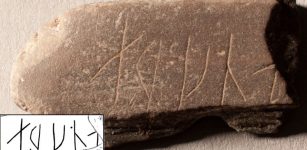 Puzzling Runic Inscription Dated To 1050-1500 AD Unearthed In Oslo, Norway
Archaeology | Dec 13, 2017
Puzzling Runic Inscription Dated To 1050-1500 AD Unearthed In Oslo, Norway
Archaeology | Dec 13, 2017 -
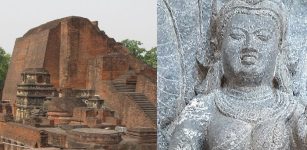 Unique 1,300-Year-Old Pala Period Idol Of Snake Goddess, Nag Devi Discovered Near Nalanda University, India
Archaeology | Apr 5, 2022
Unique 1,300-Year-Old Pala Period Idol Of Snake Goddess, Nag Devi Discovered Near Nalanda University, India
Archaeology | Apr 5, 2022 -
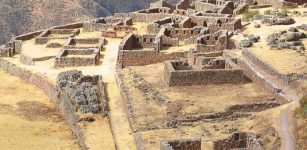 Beautiful Ancient City Of Pisac In The Sacred Valley, Peru – Incredible Inca Ruins
Featured Stories | Jun 22, 2017
Beautiful Ancient City Of Pisac In The Sacred Valley, Peru – Incredible Inca Ruins
Featured Stories | Jun 22, 2017 -
 Brutus Of Troy: First King Of Britain Or Just A Myth?
Featured Stories | Feb 16, 2016
Brutus Of Troy: First King Of Britain Or Just A Myth?
Featured Stories | Feb 16, 2016 -
 The Use Of Surnames Started During The Middle Ages In England
Ancient History Facts | Feb 23, 2016
The Use Of Surnames Started During The Middle Ages In England
Ancient History Facts | Feb 23, 2016 -
 Huge Lost Ancient Underground City Of Samen Finally Reveals Its Secrets
Archaeology | Apr 28, 2017
Huge Lost Ancient Underground City Of Samen Finally Reveals Its Secrets
Archaeology | Apr 28, 2017 -
 Cats Were Rare And Expensive During The Viking Age – Spectacular Discovery Reveals Why
Featured Stories | Jan 12, 2017
Cats Were Rare And Expensive During The Viking Age – Spectacular Discovery Reveals Why
Featured Stories | Jan 12, 2017 -
 Why Is The Battle Of Gaugamela Called Broken ‘Camel’s Back’?
Ancient History Facts | Jul 1, 2020
Why Is The Battle Of Gaugamela Called Broken ‘Camel’s Back’?
Ancient History Facts | Jul 1, 2020 -
 Evolution Of Paleodiet At Neolithic Qujialing Site Unveiled By Scientists
Archaeology | Nov 30, 2022
Evolution Of Paleodiet At Neolithic Qujialing Site Unveiled By Scientists
Archaeology | Nov 30, 2022 -
 Strange Ancient Mechanical Flying Animals – Mystery Of The Air Castle – Part 2
Featured Stories | Mar 31, 2020
Strange Ancient Mechanical Flying Animals – Mystery Of The Air Castle – Part 2
Featured Stories | Mar 31, 2020 -
 Never-Before-Seen 5,000-Year-Old Mysterious Monument On Isle Of Arran Discovered By LIDAR
Archaeology | Jan 27, 2021
Never-Before-Seen 5,000-Year-Old Mysterious Monument On Isle Of Arran Discovered By LIDAR
Archaeology | Jan 27, 2021 -
 Yasuke – The First Black Samurai Caused A Sensation In Japan
Featured Stories | Oct 25, 2019
Yasuke – The First Black Samurai Caused A Sensation In Japan
Featured Stories | Oct 25, 2019 -
 Vali – Son Of Odin, Who Avenged Death Of Balder And Survived Ragnarok
Featured Stories | Aug 29, 2019
Vali – Son Of Odin, Who Avenged Death Of Balder And Survived Ragnarok
Featured Stories | Aug 29, 2019

